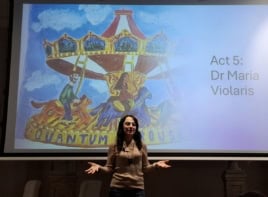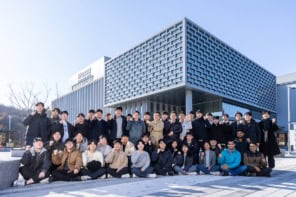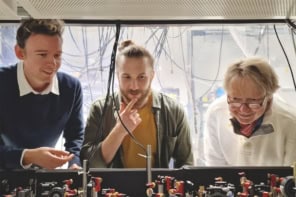Tim Prior, Quantum Programme Manager at NPL, tells Physics World how a joined-up approach to national and international standards development can help industry fast-track translation and commercialization of quantum technologies

How do standards support the translation of quantum science into at-scale commercial opportunities?
The standardization process helps to promote the legitimacy of emerging quantum technologies by distilling technical inputs and requirements from all relevant stakeholders across industry, research and government. Put simply: if you understand a technology well enough to standardize elements of it, that’s when you know it’s moved beyond hype and theory into something of practical use for the economy and society.
What are the upsides of standardization for developers of quantum technologies and, ultimately, for end-users in industry and the public sector?
Standards will, over time, help the quantum technology industry achieve critical mass on the supply side, with those economies of scale driving down prices and increasing demand. As the nascent quantum supply chain evolves – linking component manufacturers, subsystem developers and full-stack quantum computing companies – standards will also ensure interoperability between products from different vendors and different regions.
Those benefits flow downstream as well because standards, when implemented properly, increase trust among end-users by defining a minimum quality of products, processes and services. Equally important, as new innovations are rolled out into the marketplace by manufacturers, standards will ensure compatibility across current and next-generation quantum systems, reducing the likelihood of lock-ins to legacy technologies.
What’s your role in coordinating NPL’s standards effort in quantum science and technology?
I have strategic oversight of our core technical programmes in quantum computing, quantum networking, quantum metrology and quantum-enabled PNT (position, navigation and timing). It’s a broad-scope remit that spans research, training as well as responsibility for standardization and international collaboration, with the latter often going hand-in-hand.
Right now, we have over 150 people working within the NPL quantum metrology programme. Their collective focus is on developing the measurement science necessary to build, test and evaluate a wide range of quantum devices and systems. Our research helps innovators, whether in an industry or university setting, to push the limits of quantum technology by providing leading-edge capabilities and benchmarking to measure the performance of new quantum products and services.

It sounds like there are multiple layers of activity.
That’s right. For starters, we have a team focusing on the inter-country strategic relationships, collaborating closely with colleagues at other National Metrology Institutes (like NIST in the US and PTB in Germany). A key role in this regard is our standards specialist who, given his background working in the standards development organizations (SDOs), acts as a “connector” between NPL’s quantum metrology teams and, more widely, the UK’s National Quantum Technology Programme and the international SDOs.
We also have a team of technical experts who sit on specialist working groups within the SDOs. Their inputs to standards development are not about NPL’s interests, rather providing expertise and experience gained from cutting-edge metrology; also building a consolidated set of requirements gathered from stakeholders across the quantum community to further the UK’s strategic and technical priorities in quantum.
So NPL’s quantum metrology programme provides a focal point for quantum standardization?
Absolutely. We believe that quantum metrology and standardization are key enablers of quantum innovation, fast-tracking the adoption and commercialization of quantum technologies while building confidence among investors and across the quantum supply chain and early-stage user base. For NPL and its peers, the task right now is to agree on the terminology and best practice as we figure out the performance metrics, benchmarks and standards that will enable quantum to go mainstream.
How does NPL engage the UK quantum community on standards development?
Front-and-centre is the UK Quantum Standards Network Pilot. This initiative – which is being led by NPL – brings together representatives from industry, academia and government to work on all aspects of standards development: commenting on proposals and draft standards; discussing UK standards policy and strategy; and representing the UK in the European and international SDOs. The end-game? To establish the UK as a leading voice in quantum standardization, both strategically and technically, and to ensure that UK quantum technology companies have access to global supply chains and markets.
What about NPL outreach to prospective end-users of quantum technologies?
The Quantum Standards Network Pilot also provides a direct line to prospective end-users of quantum technologies in business sectors like finance, healthcare, pharmaceuticals and energy. What’s notable is that the end-users are often preoccupied with questions that link in one way or another to standardization. For example: how well do quantum technologies stack up against current solutions? Are quantum systems reliable enough yet? What does quantum cost to implement and maintain, including long-term operational costs? Are there other emerging technologies that could do the same job? Is there a solid, trustworthy supply chain?
It’s clear that international collaboration is mandatory for successful standards development. What are the drivers behind the recently announced NMI-Q collaboration?
The quantum landscape is changing fast, with huge scope for disruptive innovation in quantum computing, quantum communications and quantum sensing. Faced with this level of complexity, NMI-Q leverages the combined expertise of the world’s leading National Metrology Institutes – from the G7 countries and Australia – to accelerate the development and adoption of quantum technologies.
No one country can do it all when it comes to performance metrics, benchmarks and standards in quantum science and technology. As such, NMI-Q’s priorities are to conduct collaborative pre-standardization research; develop a set of “best measurement practices” needed by industry to fast-track quantum innovation; and, ultimately, shape the global standardization effort in quantum. NPL’s prominent role within NMI-Q (I am the co-chair along with Barbara Goldstein of NIST) underscores our commitment to evidence-based decision-making in standards development and, ultimately, to the creation of a thriving quantum ecosystem.
What are the attractions of NPL’s quantum programme for early-career physicists?
Every day, our measurement scientists address cutting-edge problems in quantum – as challenging as anything they’ll have encountered previously in an academic setting. What’s especially motivating, however, is that the NPL is a mission-driven endeavour with measurement outcomes linking directly to wider societal and economic benefits – not just in the UK, but internationally as well.
Quantum metrology: at your service
Measurement for Quantum (M4Q) is a flagship NPL programme that provides industry partners with up to 20 days of quantum metrology expertise to address measurement challenges in applied R&D and product development. The service – which is free of charge for projects approved after peer review – helps companies to bridge the gap from technology prototype to full commercialization.
To date, more than two-thirds of the companies to participate in M4Q report that their commercial opportunity has increased as a direct result of NPL support. In terms of specifics, the M4Q offering includes the following services:
- Small-current and quantum-noise measurements
- Measurement of material-induced noise in superconducting quantum circuits
- Nanoscale imaging of physical properties for applications in quantum devices
- Characterization of single-photon sources and detectors
- Characterization of compact lasers and other photonic components
- Semiconductor device characterisation at cryogenic temperatures
Further reading
Performance metrics and benchmarks point the way to practical quantum advantage
End note: NPL retains copyright on this article.




